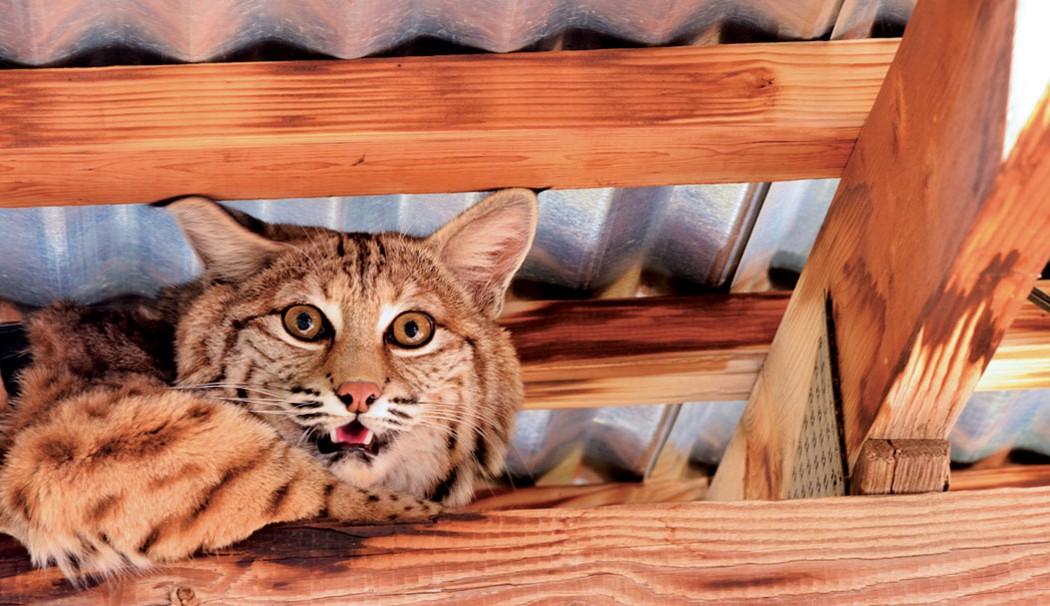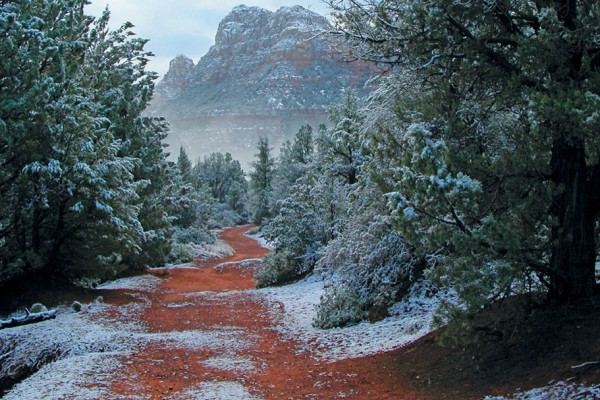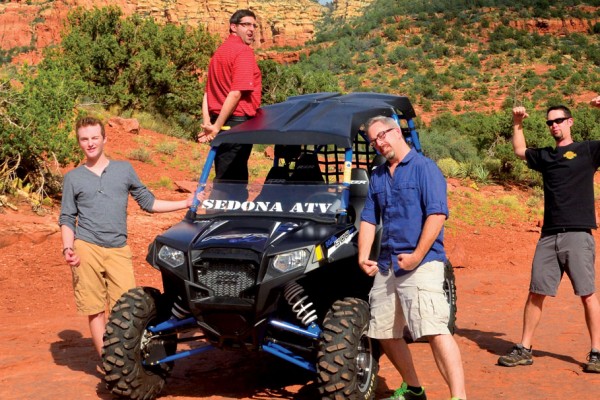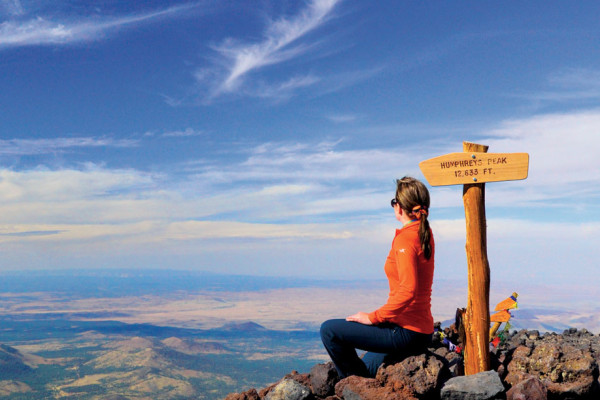Sedona wildlife sculptor Ken Rowe gently places the back of his hand in front of the nose of Sage, a 25-pound, 2-year-old bobcat. Sage flicks her ears, bringing to mind an alert housecat. She sniffs his hand and then exhales, but the whoosh of her breath feels nothing like that of a domesticated feline. With one involuntary action, she has conveyed her size, her strength and, most of all, her wild nature. Ken smiles and strokes her downy cheek. Sage closes her eyes and leans into his touch. For a brief moment, she seems to relish the attention. Then the unexpected sound of a truck causes her to flick her stubby tail and open her alert eyes.
The encounter takes place in a quiet corner of the 10-acre Southwest Wildlife Conservation Center located in rural north Scottsdale. Sage is attached to a leash, and on the other end of the leash is her handler, Kim Carr, the center’s director of education. Two years ago, a driver spotted what he thought was a tiny kitten on the side of the road. The good samaritan rescued the kitten and bottle-fed her for several days before the sleepless nights got the better of him, and he called the local humane society. Society workers took one look at the kitten and told the man he had actually been caring for a bobcat. The bobcat came to the Southwest Wildlife Conservation Center where Kim planned to raise her to adulthood and release her into the wild. But after five months in an enclosure with other cats, Sage was clearly not interested in her own species. “When a person would walk by, she’d climb the fence and start purring,” says Kim. “And when I walked into the enclosure after five months, she jumped into my arms.”
Sage had imprinted on her human rescuers, which meant she would not be suitable for release into the wild. Today, she acts as one of the center’s education animals, traveling to schools and community groups with Kim to help educate people about Arizona’s native wildlife. Sage is just one of nearly 300 animals that call the nonprofit Southwest Wildlife Conservation Center home. The center rescues wild animals, especially carnivores, that have lost their homes or have been found injured or orphaned. (SWCC has rehabbed numerous animals, including many javelina, from Sedona.) The center’s goal is to release the animals back into their native habitat, but that’s not always a possibility. For animals like Sage that won’t be able to survive in the wild, they live out their lives at the sanctuary where they are carefully cared for by a staff of six full-time employees and 75 volunteers.
Executive director Linda Searles founded SWCC in 1994; she currently lives on-site. Twenty years ago, the Arizona native and realtor was a volunteer for a bird rescue organization when she wound up taking in an orphaned coyote pup she dubbed Don Coyote. She was living in Pima at the time. “I realized there was no one out there rescuing mammals,” she says. Linda, who grew up on a ranch, relocated to north Scottsdale, and she’s actively looking to expand the operation once again to serve the need. (Remember the tigers that were found in backyards in Phoenix and Gilbert in January? They spent time at SWCC before being relocated to Out of Africa Wildlife Park in Camp Verde.) “We don’t turn anything away,” she says. “We are the only facility in Arizona specializing in the rescue of large mammals and carnivores.”
And when she says anything, she means anything. The center is home to black bears, great horned owls, mountain lions, a 40-year-old burro, domestic cats, domestic dogs, coyotes (that occasionally howl in unison during our visit), deer, javelina, foxes, coati, horses, porcupines, bobcats and Leonardo the leopard. The animals live in large enclosures, and the entire facility is shaded with mesquite and chaparral. The black bears have pools of water with water fountains to cool off in the summer, and many of the animals have hammocks where they can frequently be found swaying in the breeze. The meat eaters dine on a different meal every day, and all of the residents receive regular “enrichment,” whether it’s a Christmas tree for the bears to roll around in the winter or balls that emit animal noises for the bobcats.
SWCC also provides refuge to 17 Mexican gray wolves; it’s a member of the Species Survival Plan for the endangered subspecies of wolf. SWCC feeds and cares for part of the captive population of wolves and covers all expenses without help from federal or state agencies. The wolves are more elusive than some of the other animals. They lope around their enclosures without ever getting too close to the humans standing on the other side of the fence. Even when you don’t see them, you have the feeling you’re being watched. All of SWCC’s permanent residents except the Mexican gray wolves are spayed and neutered.
Each animal has a story, and Linda and Kim know the stories by heart. Tocho the mountain lion was orphaned in 2005 when poachers killed his mother. As a kitten, he was sold to two young men who kept him in a dark shed where he was deprived of sunlight. When he was confiscated by the Arizona Game and Fish Department and brought to SWCC, he had three broken legs and a crushed pelvis. His poor diet caused bone disease, and the only way he could move around was to pull his body across the floor using his front legs. It took months to get him healthy, but during our visit he lounged in the sun near the edge of his enclosure, purring loud enough for everyone to hear – a surreal experience.




